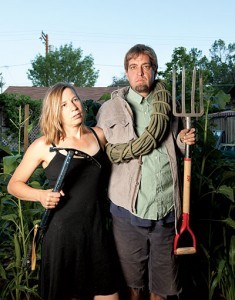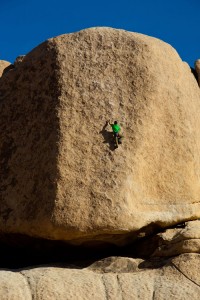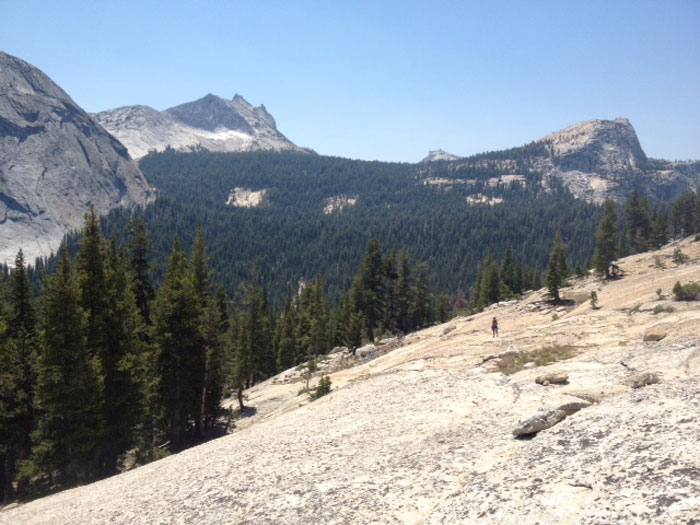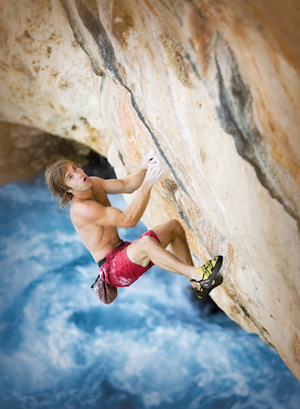- Tahoe’s Nevada Beach Tops the List of Hard-to-Book Campgrounds - 07/17/2024
- Cannabis Watershed Protection Program Cleans Up Illegal Grow Sites - 07/10/2024
- French Fire - 07/05/2024
In the land of little rain and scrubby sagebrush, a climber morphs into gardener to find some roots
By Bruce Willey

Dirt Farming Climber
June, the finest month of all, the earth in full tilt soak of the sun. Late afternoon light spills over the Sierra Crest and under the lenticular clouds. I’m sitting under an unknown grape, a vine with a trunk the girth of a large man’s thigh. It might have been planted when this house was built in 1918 … or not. Then again, there are always a lot of surprises with this old house that my wife and I bought this spring in downtown Bishop.
And this being a magazine with adventure in its title, perhaps it best to mention, there’s been a lot of that too, sometimes enough to rival any epic I’ve found on the rocks or in the water. Colonies of subterranean termites occupy my dreams at night; tearing down a wall to find a secret door leading to what might have been called a water closet at one time occupies my day. All the while, between framing up a wall or painting another coat of primer, I yearn up to the High Sierra, unable to decide whether I should be slinging an ice axe or a framing hammer.
But it’s the garden that has proved the biggest adventure of all and the reason we added “fixed rate lock,” “APR,” and “impound account” to our limited financial (in every sense of the word) vocabulary. When we saw the house we were sort of unimpressed. It was small, shoddily built, and smelled of 91 years of humanity. That is until we laid eyes on the big backyard sporting fruit trees and a long abandoned garden plot overrun by relentless Bermuda grass. We made an offer after mulling it over for three weeks only to discover another real estate idiom: 60-day escrow.
With the summer growing season fast approaching this meant only one thing. In order to get a garden growing we would be forced to become trespassers. The owner lived out of the area and we asked if we could simply water his property. He agreed. We watered in accordance to our agreement but we also hand weeded out a 40-by-25 foot plot, hauling four pick-up loads of the insidious grass to the dump. Meanwhile, a block away where we rented a small studio, we planted seedlings in plastic containers and peat pots.
Sierra climbing legend and skilled building craftsman, John Fischer, came over to look at the place we intended to buy. He shrugged at the visible dry rot, the leaning walls, the squeaky floor, the mounds of earth out back. He was silent for a while, not a good sign since we were planning on hiring his expertise on the work we would no doubt get in over our head. Finally he said (and I quote him loosely since there is no way to verify exactly what he said because John tragically died June 5 after hitting a deer on Hwy 395; Ed. Note: Look for a tribute to John Fischer in our September issue), “You probably know the story of French climbers Lionel Terray and Louis Lachenal, mountain guides in Chamonix who became itinerant farmers to make ends meet. Most days found them looking at their hoes then up to the high peaks then down at their hoes again. They looked at each other, dropped the hoes and grabbed their packs and headed up into the mountains.”
By the time escrow had closed beginning of May the garden was planted. Yet John Fischer’s underhanded but wise metaphor rang in my head. The only way to solve it I figured was to install an automatic-drip system with a timer. That way we could go into the backcountry for at least four days and still have a well-watered garden. Problem solved, we headed off to Vegas for the 17-pitch classic Epinephrine in Red Rocks. When we returned, scrubbed and scabbed by the notorious chimneys, the plants had grown twice as fast than if we would have been staring at them each day. Funny how that works.
So, a couple months since we have become Eastside farmers, reckon it’s time I take you on a garden tour from where I’m sitting. I moved from the unknown grape to under the cherry tree and feel rather like Bacchus with my wheat beer and a mouthful of fresh plucked cherries. Much like a climber who finds pleasure in doing a good route again just to show it to another climber, there’s not a gardener I know who doesn’t want to give a tour around the rows of vegetables and herbs so lovingly tended.
We’ll begin in what I’ve dubbed the Midwest ode to monoculture — corn, sunflowers, and soybeans. Monsanto isn’t welcome here, so they’re the only crops that hearken back to my paternal genetic roots in North Dakota. The only thing missing is wheat waving in the wind, which partly explains the hefeweizen in my hand. Next year. But I’m most excited about the corn seed I scored from an organic seed company. Propagated from a 4,000 year-old Anasazi Indian archeological site, I’m hoping this blue, yellow, and red kernel sweet corn will tap into North America’s rich agricultural past before white men like me arrived. Maybe I’ll even have some psychedelic visions after eating it and I’ll chip petroglyphs into the rocks I’ve pilfered from Bishop’s Tablelands (where many glyphs are found). But this is no doubt also the thinking of the white man in me. If all else fails at least I’ll deserve some federal farm subsidies for growing this much corn.
Next we move to what we call the salad bowl, another ode, but this time to the Salinas Valley, a hop down the 101 from Santa Cruz where I got my gardening chops started in the first place. Here we have lettuce, arugula, broccoli rabini, chives. Only thing missing is the artichoke and the Brussels sprout to round out the geographical metaphor. Again, next year. Given that Bishop has not a wisp of cooling sea fog, I’ve placed an arch of PVC pipe draped in shade cloth to make the leafy lettuce think they might not exactly be sweltering under the summer heat and bolt (or is it revolt?) into flower before wilting.
A row down, we arrive at a row of bean poles with of course beans climbing and writhing up the string and wire. That’s what they do best. Garlic covers the edges along with New Zealand spinach, Swiss chard, and watermelon radishes—green on the outside, deep red on the inside. I suppose it’s a good name but I hope they still taste deeply like radishes.
Then the ubiquitous tomato row next door crowned by a tarragon bush that I left from the previous owners gardening wisdom. Apparently these two plants are companions, the marjoram keeping pests away and providing a nice flavor to salads. At the end of the tomato row—mostly heirlooms and a cherry toms— is a small watermelon patch that has suffered then recovered twice now from late season frosts.
A row down and we arrive at the root crops—beets, carrots, sweet potatoes, and more garlic. Some of these seedlings were devastated by earwigs, especially the carrots. Which is why I hear the grating sound of my wife cutting plastic bottles with a dull knife to fit over the plants. She seems to think the earwigs will have a more difficult time climbing up the smooth plastic. With organic gardening if it works 20 percent of the time you might as well call it a triumph as long as you have another method—companion planting, attracting helpful insects to eat the not-so-helpful pests and the like—taking a another 20 percent swath. Most times, though, you just find a healthy resignation at nature’s persistence both in favor of your efforts and the one’s you can’t avoid.
Last we arrive at the hot feet row, the dancers of the garden, the squash, the sweet potatoes, the crook-necks and Kumi-Kumi squash (a native Maori squash). I thought of growing some zucchini but thought better of it after hearing my uncle’s yarn: “The only time we lock our doors in Maine is during zucchini season.”
I’ve had to ask myself what does this all mean? Well, it’s decidedly in line with the slow food movement. Though we haven’t bought a vegetable from Von’s supermarket in three weeks, living as we are on lettuce, broccoli rabini, radishes, beets, and chard, we would have starved while we watched our seedlings turn into proper, edible plants. Now each time we eat there’s an overwhelming hint of the good earth that we toiled in. Gardening, we’ve found is the slowest food movement out there and sometimes the slowest is the most satisfying.
Wendell Berry, one of the first great food and gardening writers, wrote that “the corporations will grow, deliver, and cook your food for you and (just like your mother) beg you to eat it. That they do not offer to insert it, pre-chewed, into your mouth is only because they have found no profitable way to do so.”
I’d like to think we are not growing our own for political reasons or we think it’s the end of the world. But maybe we are in some ways. There are definite tangibles that I can’t explain away with a gardening bias. We’re climbing harder, filled with more energy. The taste is different, too, drenched with flavor and I suppose if I were a meat eater it would be akin to eating something that roamed freely rather than slaughtered on a factory farm. The vegetables have a fibrous zest, almost a gamey aspect to them. And if I prevail to discuss what comes out the other side with the hopes you are not having lunch, my bowel movements have gone from G-flat sharp to G-major with Mahleresque proportions and even profundity helped along by a good book.
But we’ve all become bone-tired of another gardening article eschewing the virtues of growing your own while making a stab into the heart of big agriculture/petro-chemical industry. Yes, it’s the right thing to do probably, if you can find some land and some precious time. The good thing is the country is shifting slowly in the right direction. There’s an organic White House garden to replace the solar panels that Reagan ripped down. People are beginning to question what and if it’s food they are eating. We see more and more organic vegetables even in places like Wal-Mart. Farmer’s markets bring it all down to the local level with a garden of your own being as local as it gets. It’s mainstream and turning into a veritable movement.
But food politics and movements seem far removed from this garden. The plants could care less (or do they?). A little water (thanks LA Water and Power), good soil, a loving pat on a leaf now and then is all they require. Time to put down the hoe, then. The mountains are calling.
Thanks to their automatic-drip system, writer Bruce Willey and his wife Caroline Schaumann can sow seeds and multi-day climbing adventures all at once. You can read more of his fertile words at www.brucewilley.com and witness his camera work at www.plumephotoproductions.com.













